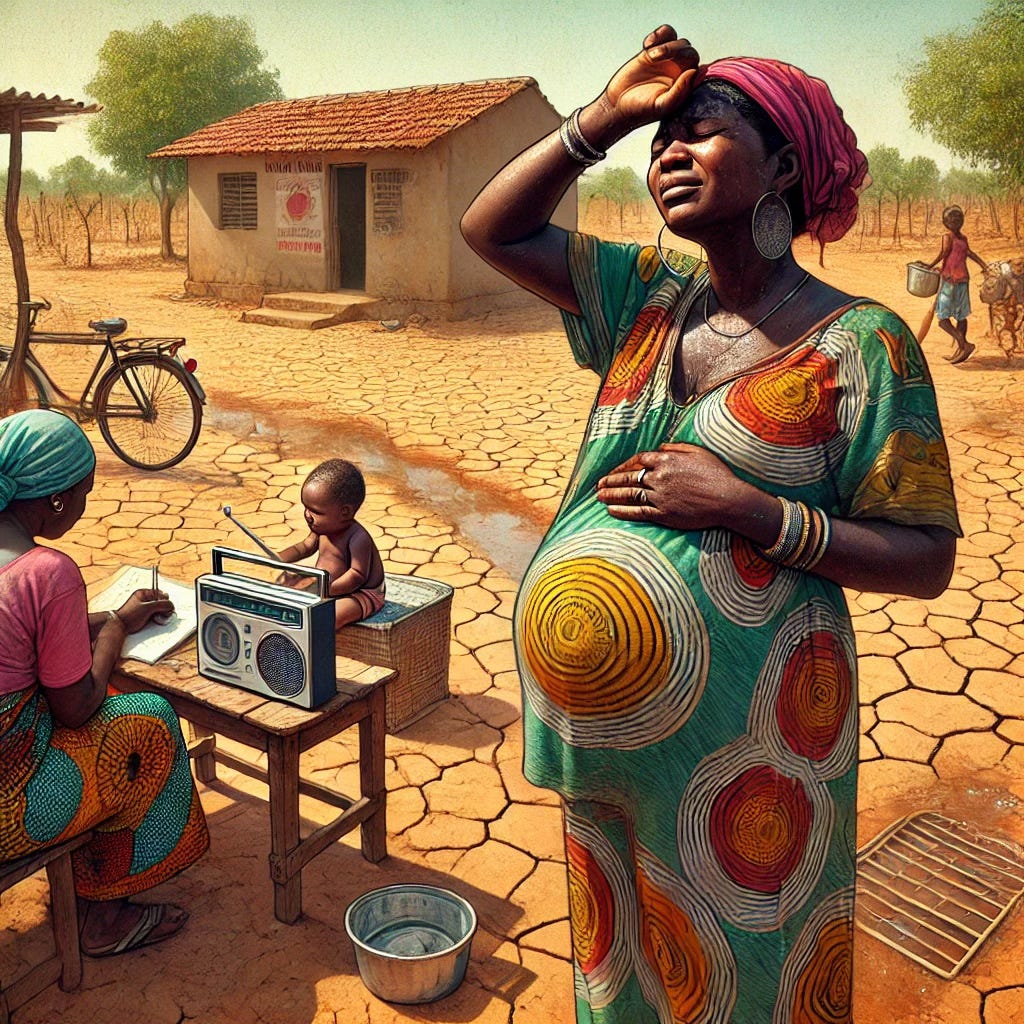Rising Temperatures: What It Means for Expectant Mothers in Africa
This edition explores how extreme heat can affect birth outcomes, with highlights on Africa's HIV burden, the origins of Rwanda's Marburg virus, the disappearance of Uganda's cranes, among other topic
CREDIT: Chatgpt
If you’re young—like me—and planning to have a family, there’s an emerging challenge you may not have considered: the impact of heat exposure on childbirth.
Across Africa, research on this subject remains scarce, but a groundbreaking study has revealed a troubling link between extreme heat and birth outcomes in the coastal city of Mombasa, Kenya.
The findings indicate that high temperatures increase the likelihood of caesarean sections and low birth weight in newborns.
“Our study provides valuable insights into the relationship between heat exposure and maternal and perinatal health outcomes in Kenya,” the authors note, adding that it lays a foundation for future research and policy interventions aimed at protecting vulnerable populations.
The study, conducted at Aga Khan University Hospital between 2017 and 2022 and published in The Journal of Climate Change and Health in January, found that women exposed to high temperatures in the month of birth were 21% more likely to undergo a caesarean section.
Additionally, newborns were 26% more likely to be underweight if their mothers experienced extreme heat, particularly in the final trimester of pregnancy.
With climate change driving global temperatures higher, the study warns that maternal and neonatal health risks will continue to rise. Authors of the paper call for stronger maternal healthcare strategies, including heat adaptation measures in hospitals and awareness campaigns for expectant mothers.
Social and economic implications
Other researchers, such as MF Chersich and colleagues, have argued that climate change affects pregnant women in Africa through social determinants of health, including poverty, migration, displacement, and conflict.
Furthermore, extreme weather events like flooding disrupt health services and infrastructure, while rising temperatures expand the geographical range of infectious diseases, further endangering expectant mothers.
In Africa, a study by Salifu Dumbuya and colleagues found that a 1°C increase in temperature in the week before delivery is associated with a 6% increased risk of stillbirth. “This suggests that high temperatures heighten the risk of pregnancy complications, including preterm delivery and stillbirth,” the authors warn.
From a global perspective, Mia M. Blakstad and colleagues have said that climate change exacerbates maternal malnutrition by affecting food production. Unpredictable rainfall and rising temperatures disrupt agriculture, reducing food supply and increasing the risk of malnutrition for pregnant women.
QUOTE OF THE WEEK
“In sub-Saharan Africa, every week, 3100 adolescent girls and young women acquire HIV at three times the rate of adolescent boys and young men. Most of these infections in adolescent girls and young women are acquired from male sexual partners who are about a decade older, with limited agency to negotiate safe-sex practices,” Tanuja N Gengiah and Quarraisha Abdool Karim in the Lancet HIV, make case on how to prevent HIV among young women in Africa.
CHART OF THE WEEK
Around the time Americans were fighting for independence, Africa was receiving all kinds of visitors with various interests—some were researchers studying the continent’s freshwater snails. This visual is from a paper–mentioned in research highlights–that traces research on African snails since the 1750s.
NEWS HIGHLIGHTS
Wycliffe Muia, BBC, writes that the crested crane, with its golden crown, red throat pouch, and slender black legs, is beloved in Uganda, appearing on the national flag and coat of arms. However, it faces extinction. In the 1970s, over 100,000 existed, but today only 10,000 remain.
Dann Okoth, Nature, writes about how an international team of 84 researchers from institutions across Africa, Europe and North America reported that chimpanzees have genetic adaptations that mirror those responsible for malaria adaptation and resistance in humans.
Kat Lay, The Guardian, writes how Rwanda’s first Marburg outbreak initially had no clear source. But investigations revealed a 27-year-old miner at Gamico Mining Ltd fell ill alongside his wife, who later died. Experts traced the virus to tunnel 12, where bats roosted. Fourteen coworkers had Marburg antibodies, confirming the site as the outbreak’s origin.
RESEARCH HIGHLIGHT
Joyce Kimutai and colleagues in ScienceDirect paper explain how Human-induced climate change increased 2021–2022 drought severity in horn of Africa. Between October 2020 and early 2023, Eastern Africa faced its worst drought in 40 years due to five consecutive failed rainy seasons. This led to harvest failures, livestock losses, water shortages, and conflicts, affecting 4.35 million people. Analysis of rainfall and temperature trends revealed that human-induced climate change intensified the drought by reducing rainfall and increasing evapotranspiration.
Anubhab Khan and co in Molecula Biology journal explain how, while researching in Kenya and Tanzania, they used DNA from tsetse flies to develop the best practices for conducting population genetic studies, particularly on mammals that are difficult to get close to for sampling, such as elephants and buffalo.
Matabaro Ziganira and Colleen T. Downs in Ecology and Evolution journal discuss the significant Progress in the study of African freshwater snails over the past 260 years. The scientific study of African freshwater snails began about and a half centuries ago with the arrival of European traders and explorers.
—END—






